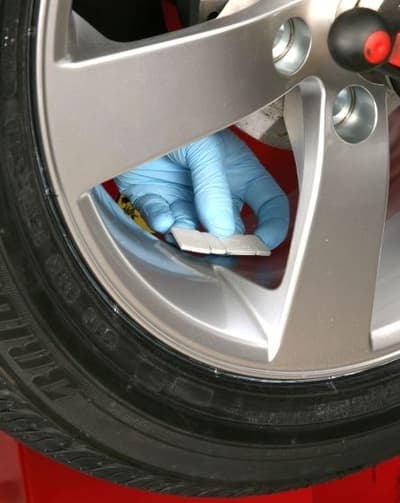What is wheel balancing?
Wheel balancing is the process of attaching small weight’s to a wheel’s rim to distribute the weight of the wheels evenly on each axle. This means that as a wheel rotates the full circumference of the tyre is in contact with the road ensuring a consistent wearing of the tyres across the width. Uneven wearing leads to an uncomfortable ride and can pose a serious safety risk for passengers.
To balance wheels, they are removed from a car and loaded onto a balancing machine which spins the wheel to determine where the weights need to be placed to correct any imbalance.

How long can you drive on unbalanced tyres?
Whilst there is no set time frame to answer this, it is recommended that you get the balance of your wheels checked as soon as you notice any of the signs that they may be unbalanced.
If there are no signs of imbalance it is still worth checking at regular intervals, this is because when a new tyre is fitted to a wheel the wheels are then balanced to level out the full weight of the wheel and the tyre with 8mm of tread on it. As the tyres are used, the tread wears down and the overall composition of the tyre on a wheel changes and should be checked to see if it needs re-balancing to compensate. Hitting kerbs or potholes in the roads can also cause the weights to move.
It is important to remember that unbalanced wheels not only cause premature wearing of your tyres but that they can also cause issues with your suspension system and wheel bearings.
The additional stress on these car parts leads to poor fuel economy, eventually costing you much more in the long run than the cost of balancing each wheel!
How much does it cost to have wheels balanced?
Here at National a wheel balance will cost just £6.50 per wheel. If you are purchasing a tyre, the wheel balance will form part of the fitting costs as standard to ensure your tyres are in the best possible condition when you drive off from one of our branches.
Do I need to balance all 4 tyres?
Wheel balancing enables you to get the best performance from your car. The tyres fitted to the outer part of the wheel are the only part of the car that are in contact with the road so it is vitally important that they are performing at an optimum level. Wheel balancing fine tunes your tyres performance, therefore balancing all four wheels in one go will improve the driving experience and save you money by improving the fuel economy.
It is advised that the wheels are balanced whenever the wheel and tyre are removed, so if you sustain a puncture and the tyre is being repaired or replaced with a new one, the wheels will need balancing before they are put back on the car.
What is wheel alignment?
Wheel alignment, often referred to as tracking differs from wheel balancing in that the tracking is concerned with angle and the direction of the wheels on the car. Aligning the tyres on each axle to ensure that they are both pointing forwards instead of toeing-in or toeing-out. Correcting the angles of the tyres ensures that they come into contact with the road correctly.
As with unbalanced wheels, misaligned wheels will also cause premature wearing of your tyres and lead to poor fuel economy. Both the alignment and the balance contribute to a smooth, comfortable ride.
Should I balance the wheels before an alignment?
Whilst not mandatory to balance wheels before an alignment is carried out, it is advised that for your comfort and above all else safety, that you ensure the wheels are balanced, tyres are set to the correct pressures, the tyres general condition is good and the treads are above the legal limit for driving on in the UK.
If in any doubt about any of the points covered in the article, pop down to a branch near you and one of our highly trained technicians can carry out a FREE wheel balance check for you.
Did you enjoy this blog post? |4 people found this review helpful



 Sign up for SPECIAL OFFERS
Sign up for SPECIAL OFFERS
